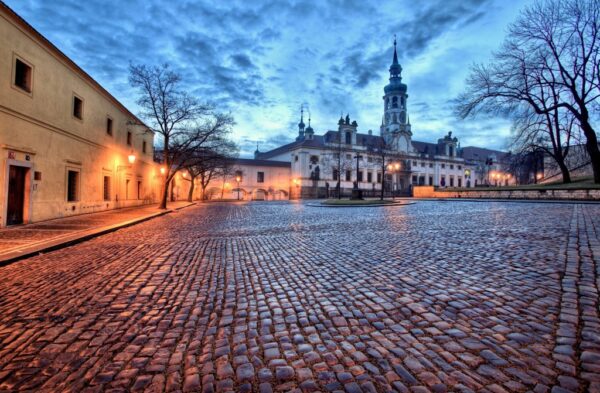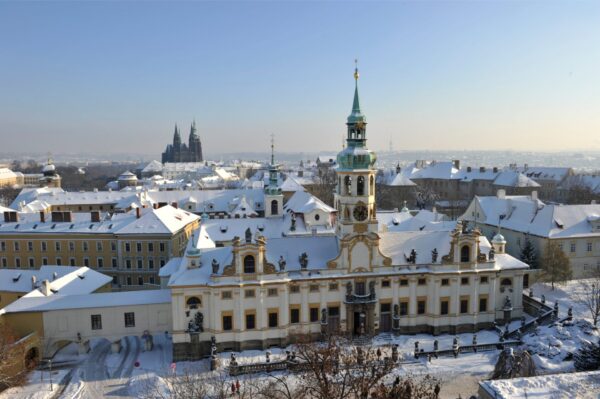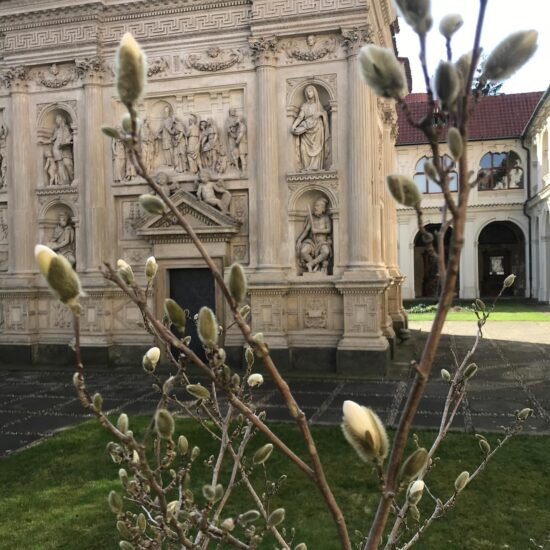Loreta Complex
Moving west along Loretánská street it won’t be long before you reach Loretánské námestí (Loreta Square) that takes its name from the famous Loreta Complex. The square is dominated by the massive Czernin Palace (Cernínský palác) which extends over the whole western side with its 150 meters long frontage.
It is the largest of all the Baroque Palaces of Prague and was built in 1668 by an Italian architect for Jan ernín, an Imperial delegate in Venice, and a member of one of the oldest noble families in Bohemia.


Czernin Palace has served as a picture gallery, a shelter house for the poor, and a barracks. From 1920 on it has been the seat of the Ministry of Foreign Affairs. On the opposite side of the square lies the religious complex that gave its name to the square.
The story behind the Loreta easily matches the amazing architecture of its cloisters, Church & Santa Casa as well as the invaluable worth of its treasures. The Loreta was also built by an Italian architect after 1626, for Baroness Katharina of the noble Lobkowitz family who had at its possession quite a few palaces at the time. The Baroness was obsessed with the story of Santa Casa of Loreto in Central Italy.
According to the narrative the house at Nazareth in which Mary had been born and brought up, had received the Annunciation and lived during the Childhood of Christ, after his Ascension, was converted into a church by the Twelve Apostles.


In 336, Empress Helena made a pilgrimage to Nazareth and directed that a basilica be erected over it, which worship continued until the fall of the Kingdom of Jerusalem. In 1291, to save it from destruction a Greek family of pilgrims named Angeli (Angels in Greek) dismantled the church and moved the stones to Croatia.
A few years later it was again relocated to its current position in Loreto, Italy. The whole adventure was attributed to a miracle carried out by angels and many copies of the Santa Casa sprang up throughout Catholic Europe. The whole complex in Prague evolved around the Czech version of the Santa Casa which is an almost exact copy of the original.


The outer walls of the House are decorated with sculptures and reliefs depicting scenes from the life of the Virgin Mary and Old Testament Prophets who foretold the birth of Jesus and the Virgin Mary.
Inside the murals from the 17th century depict scenes from Mary’s life while a wonder-working statue of Our Lady of Loreto made of linden wood rests in a rich, wrought silver frame from 1671.
Although the Santa Casa in Italy is built inside a church, Prague’s stood alone with the rest of the cloister gradually surrounding it over the 17th & 18th centuries. The Rococo Church of the Nativity of Our Lord (Kostel Narození Páne) In the middle of the eastern side, the Chapel of St. Anthony of Padua bears beautiful frescoes, paintings, and statues.


Its famous treasury contains approximately 350 jewels and treasures accumulated by the nobility after the Battle of White Mountain, which took place a few kilometers away, in 1620. Its most valuable piece is the “Sun of Prague” made of gold-plated silver and decorated with 6.222 diamonds. Another noteworthy feature of the Loreta complex is the Baroque Bell Tower which houses a carillon of not less than 30 bells cast in Amsterdam in 1691. It offers exquisite views of the surroundings. More about the whole complex




